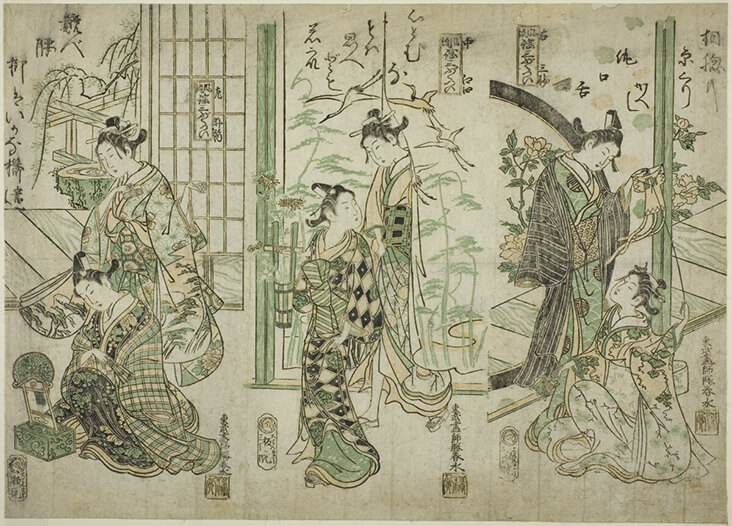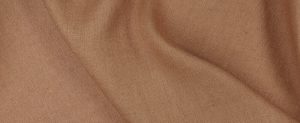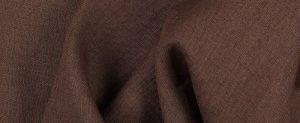Fabric in Ukiyo-e Art: The Katsukawa School

Miyagawa Shunsui, A Triptych of Fashionable No Plays (Furyu Utai Sambukutsui), 1750s, via The Art Institute of Chicago
In this latest edition on fabric in ukiyo-e art, we will look into the fascinating art of the 18th and 19th century Katsukawa School, and the vital role Japanese costume and silk played in its development. Founded by the great Miyagawa Shunsui, the incredible art of the Katsukawa School spanned paintings and prints with a focus on three core themes: kabuki actors (yakusha-e), sumo wrestlers (nikuhitsu-ga), and beautiful women (bijin-ga). In later years, landscape scenes were explored by some. As we shall see, in each of these areas fabric was integral, allowing artists to tell vibrant, spirited stories that were bursting with character and life.
Founder of the Katsukawa School, Miyagawa Shunsui was one of the leading artists of his generation, and his busy workshop in Edo produced some of the most striking artworks of the 19th century (he changed his last name to Katsukawa in adulthood). He took his lead from the earlier Torii School of ukiyo-e, specialising in painting and print depictions of kabuki actors, but he gave them greater qualities of detail and expression than ever before, advancing on the ideas of his predecessors.
In the stunning and richly complex colour woodblock print, A Triptych of Fashionable No Plays (Furyu Utai Sambukutsui), 1750s, six women are arranged theatrically across the scene. If we look closely, their clothing has a daringly fresh variety of marks and prints, ranging from floral motifs to diamond prints, stripes and checks, revealing the expressive and emotive qualities of printed fabric. This array of clashing prints demonstrates the wide variety of fabrics being produced in 18th century Japan, and he skillfully unites them into one with a unifying colour scheme of greens, soft blacks and yellows.
Made at a similar time, the daring and direct ink on silk scroll painting Young Woman with a Book from the mid-18th century explores how large areas of flat, empty space can be enlivened with one small, concentrated area of intensely worked detail. Here Miyagawa makes the warm, sandy beige of the silk background a fitting stage for his singular actor. Her intensely detailed clothing is awash with colour and life, forming intricate ripples and folds of touchably soft silk robes that buckle and bunch around the tiny figure’s body, almost engulfing her in their depths. Again, clashing fabrics become a theatrical device, with swirling stripes conveying movement and dark, heady florals with a hint of daring red adding depth of weight and drama.
A wide variety of leading artists emerged from the Katsukawa School in their master’s wake. One of the most prominent was the great Kastsukawa Shunsho, who, like his teacher, also portrayed kabuki actors and beautiful Japanese women in his paintings and prints. However, his style is distinguished from others by his particularly profound depth of character and crisp, bright colour. The visually arresting woodblock print The First Nakamura Tomijuro as an Outlaw, 1775, demonstrates the heightened drama that Shunsho enjoyed conveying in his art; the stage actor here stands as if mid-action, with an overtly exaggerated posture and facial expression. This kabuki actor is staged in layers and layers of clothing that ripple and bunch over his body to give him a masterful strength of character. Shunsho particularly emphasises the varying textures and patterns of his indulgent clothing, including striking oversized florals, stitched stripes and large, dramatic crisscrosses.
Shunsho’s painted scroll Beauty with Butterflies, 18th century, is even more resplendent, with a young woman adorned in stunning shades of midnight blue and blazing red, all peppered with an intricate array of clashing floral motifs. Such was the popularity of Shunsho’s paintings and prints in his day, one writer of the time observed, “A painting by Shunsho is worth one thousand pieces of gold.”
Other artists of the Katsukawa School who reached similar levels of success include Shun’ei, Harunobu and, perhaps the best-known ukiyo-e artist in the west, Katsushika Hokusai (known earlier in his career as Katsukawa Shunsho). Although Hokusai was best known for his light-filled landscapes featuring Mount Fuji, small, dynamic figures often featured in his art wearing brilliantly hued clothing, sparkling across the surface of his art like an array of luminous jewels.


















































5 Comments
Anita Miller
Thank you for this beautifully written and fascinating blog. Your writing causes me to delve more deeply into the prints you shared as well as inspire me to consider the use of pattern and drape. Actually, there are many layers of insight and information here that I’ll be re-reading it several times.
Kudos to this company for valuing education and inspiration. There is a direct correlation between the inspiration from Rosie and my desire to keep creating.
Thank you.
Anita Miller
Rosie Lesso
Thank you so much – its very uplifting to hear!
Suzanne Ubriaco
Such an interesting article! I absolutely love the variety of colors and patterns in View of Mount Fuji from Porch. I find the muted tones against the indigos breathtaking. The reprints changed the colors that I find disappointing. Can you share where this print is currently?
I enjoy all your essays. So well written and educational while providing inspiration for creativity. Thank you, Suzanne
Rosie Lesso
I also adore this print! The Brooklyn Museum seem to have a version of it – https://www.brooklynmuseum.org/opencollection/objects/53573 but there may also be more out there…
Rosie Lesso
And also thank you for the inspiring comments too!